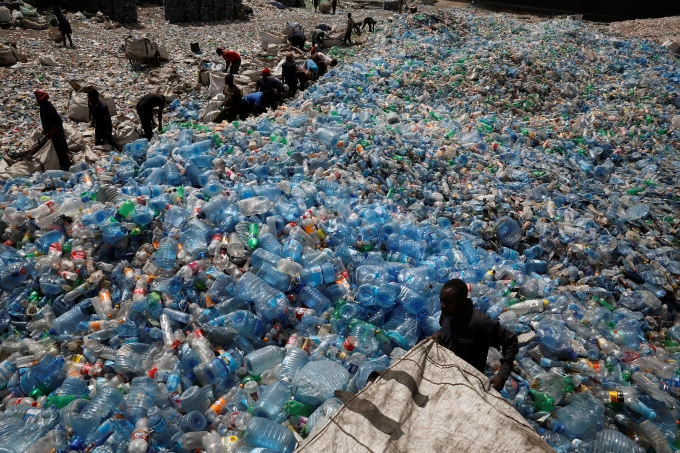A team of researchers at Northwestern University in the United States has unveiled a chemical recycling method that could significantly change how the world manages plastic waste. Their work, published on September 2 in Nature, introduces a nickel-based organometallic catalyst capable of selectively breaking down two of the most common and problematic plastics: polyethylene (PE) and polypropylene (PP). Together, these polyolefins represent nearly two-thirds of the world’s total plastic production, yet they are among the least recycled materials.
Polyethylene and polypropylene are widely used in everyday products, ranging from shopping bags and food wraps to baby bottles, yogurt containers, and condiment bottles. Because they are often designed for single use, they contribute heavily to the growing mountain of global plastic waste. “These types of plastics have very short lifespans and are mainly single-use. Without efficient recycling, they end up in landfills for decades before breaking down into harmful microplastics,” said Yosi Kratish, a co-author of the study.
Despite their prevalence, polyolefins are notoriously difficult to recycle. According to a 2023 Nature study, their recycling rate remains as low as 1 to 10 percent. Meanwhile, the plastics industry continues to produce more than 220 million tons of polyolefin products every year. One of the greatest obstacles has been the sorting process. Different plastics have distinct properties and melting points, meaning they cannot be recycled together. Moreover, contamination — whether from leftover food, mixed types of plastics, or non-plastic materials — often leads to the failure of entire recycling batches.
Current recycling technologies have proven inadequate. Mechanical recycling, the most common method, involves shredding, melting, and reprocessing plastic into pellets. However, the resulting material is usually of lower quality and limited in its applications. Chemical recycling through pyrolysis, in which plastics are heated at extremely high temperatures (400–700°C), produces liquid and gaseous byproducts that can be reused, but the process consumes large amounts of energy and remains inefficient.
The new Northwestern process takes a different approach. It uses hydrogen and a nickel-based organometallic catalyst — organonickel — to selectively break carbon–carbon bonds in polyolefin chains. The catalyst works like a “scalpel,” slicing through the tough chemical backbone of PE and PP while leaving other plastics untouched. This selectivity means mixed plastic waste can be processed without prior sorting, a major breakthrough in efficiency and cost. The process converts low-value plastics into oils and waxes that can be upgraded into higher-value products such as lubricants, fuels, and candles.
Another striking advantage of the method is its tolerance for contamination. Polyvinyl chloride (PVC), a common but problematic plastic, has long been a thorn in the side of recycling facilities. Found in pipes, flooring, and medical equipment, PVC resembles other plastics but is chemically unstable when heated. During decomposition, it releases hydrogen chloride gas, which is highly corrosive and can deactivate most catalysts, bringing recycling operations to a halt. In the Northwestern process, however, the presence of PVC has the opposite effect. Rather than shutting down the reaction, PVC residues actually enhance catalytic performance. Even when up to 25 percent of the plastic waste stream contained PVC, researchers observed improved efficiency in the recycling process.
While chemical recycling itself is not new, previous methods have relied on expensive catalysts such as platinum and palladium, both precious metals in the platinum group. These materials, while effective, are rare and costly, making large-scale application impractical. Nickel, by contrast, is abundant, inexpensive, and widely available. The organonickel catalyst developed by the Northwestern team requires only half the hydrogen pressure used in other nickel-based processes, consumes ten times less chemical input, and yet achieves tenfold higher catalytic activity.
This combination of selectivity, efficiency, and affordability could make the new method a game-changer for the plastics industry. By dramatically reducing the need for sorting and allowing mixed, contaminated waste to be recycled, it addresses one of the biggest bottlenecks in plastic waste management. Furthermore, the ability to transform discarded plastics into higher-value products could improve the economics of recycling, providing new incentives for industries and municipalities to adopt the technology.
Globally, the accumulation of plastic waste has become one of the most pressing environmental challenges. Plastics take centuries to degrade, and as they break down, they release microplastics that contaminate soil, rivers, and oceans, with potential risks for ecosystems and human health. Finding scalable solutions is therefore a top priority.
According to the researchers, their nickel-based process could provide a realistic path forward. “Our goal is to create a method that is not only effective in the lab but also scalable in industrial applications,” Kratish explained. By using inexpensive and abundant materials while maintaining high efficiency, the process has a better chance of being adopted commercially.
If widely implemented, the breakthrough could raise polyolefin recycling rates well beyond today’s negligible levels, cutting down on the billions of tons of waste that would otherwise end up in landfills or leak into the environment. It could also mark a critical step toward building a circular plastics economy, where materials are continuously reused instead of discarded.
As the world grapples with the environmental cost of single-use plastics, innovations like Northwestern’s organonickel catalyst demonstrate that science and technology can play a decisive role in turning waste into resources. The next challenge will be scaling up the process, bringing it from laboratory experiments to commercial facilities capable of handling the enormous volume of plastic waste generated each year.

